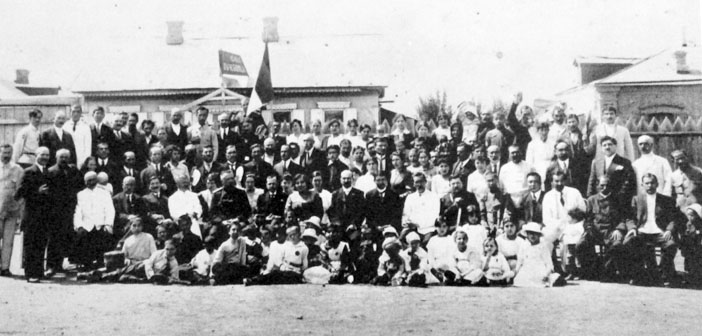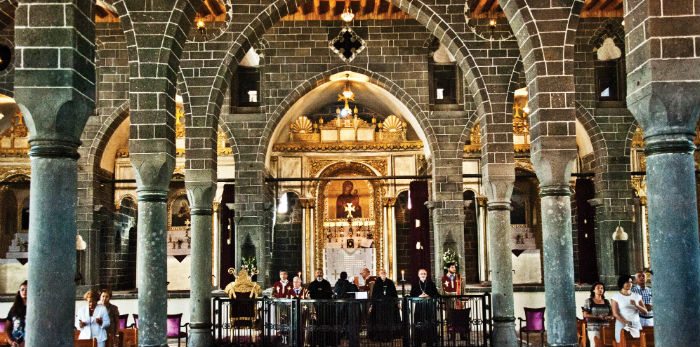Christmas is celebrated with great joy and excitement by billions of Christians, and in recent times, has also become a visual spectacle. The Christmas spirit reveals itself in the intense activity during festive season, but it obviously does not mean anything special in countries where Islam is the predominant religion. The situation in Turkey is slightly different. After all, this is a country that has been home to both Christians and Muslims in the past and today. Although today the state would have us believe that 99% of the country’s population is made up of Muslims, Christmas is still celebrated in Turkey, and besides, at two separate dates. The first, as in the most of the Christian world, is December 24-25, and the other is January 6, on which Apostolic Armenians celebrate Surp Dzınunt, and the Orthodox world celebrates the baptism of Jesus Christ. We wanted to find out how the now very few Anatolian Christians spend Christmas, and asked our questions to residents of different cities.
Sivas: Indoors celebration in winter country
Once the majority population of the city, the few remaining Armenian families of Sivas come together to celebrate New Year. Since the city is covered in snow at this time of the year, the Sivas Armenians have a very colourful time during Christmas and New Year. Yervant Durmazgüler, one of the few Armenians who continue to reside in Sivas, explains: “Here we have very colourful New Year and Surp Dzınunt celebrations, since the dates are close, the preparations for both days are done together. We often have a white New Year, and the celebrations are held indoors, with family and friends.”
A rich table for New Year
Durmazgüler also mentions the diversity of New Year and Christmas table: “The turkey is sent to the bakery’s oven in the neighbourhood, and the stuffed turkey with seasoned rice form the centrepiece of a great New Year and Christmas dinner table. On the evening of December 31, a special dessert, similar to ashura, but which contains coarse wheat, grape molasses and yellow grapes, and is called ‘gorgit’ is made. Preparation for Dzınunt, which is on January 6, begins one or two days before. Trotters soup, stuffed leaves and pastry desserts are the highlights of the Dzınunt dinner table.”
Christmas Greeting from Official Authorities
Durmazgüler then explains the importance of celebrating Christmas in Anatolia: “In Anatolia’s warm and sincere environment, we share both our joy and sorrow, and connect to each other with strong ties. Our Muslim neighbours are also aware of the fact that Christmas is a special day for us, and always come to greet us. In recent years, besides our neighbours, the Governor, Mayor and Police Chief have also visited us at our homes and presented their greetings for Christmas.”
Diyarbakır: Dzınunt at the Syriac Church
Diyarbakır is another city that had a large Armenian population in the past, and both Christmas and New Year are celebrated with great joy and excitement. However, since not many Armenians live in Diyarbakır anymore, the celebrations are held at the Syriac Ancient Virgin Mary Church. Let us lend an ear to Melike Dara Günal, as she tells us about Christmas and New Year celebrations in Diyarbakır: “We have no religious official at the Surp Giragos Armenian Church, so we can’t hold mass. That’s why we often take part in mass at the Syriac Ancient Virgin Mary Church. Or for a more entertaining and crowded festival, we go to Mardin. Since there are no Armenian religious officials in the region, many of our traditions have commingled with those of our brother Syriac people. For instance, celebrating Christmas on December 25 rather than January 6… It is pretty much the same as everywhere else in the country. And people are prejudiced, since they don’t know the difference between Christmas and New Year.”
‘They think New Year and Christmas is the same thing’
Günal explains that many people in Diyarbakır think that New Year and Christmas is the same thing, and are surprised when they find out that they are, in fact, separate days: “They think it’s the same day, so many conservative Muslims are against celebrating this Christian tradition. It is worth seeing their surprise when they find out that Christmas is actually on December 25. Some even think they have missed out on New Year celebrations for nothing, because others have told them it is a Christian tradition.”
Wine: The centrepiece of Christmas tables
Melike Dara Günal tells us that in addition to turkey, that is synonymous with Christmas, the special dishes of the city such as kaburga [spare ribs] and tas kebabı [lamb stew] also feature on Armenian dinner tables in Diyarbakır. Günal adds that wine and meze are the indispensable centrepieces of Christmas and New Year tables for the Christians of Diyarbakır.
Günal states that, following the renovation of the Surp Giragos Church, New Year celebrations have been held at Church for the past two years, but there are those who prefer to celebrate this special day at home: “For me, it is special to celebrate this day together with our Syriac sisters and brothers, although our New Year is on January 6… However, there are many Islamised Armenians who do not observe this tradition… Christmas is another matter, there are very few Christian Armenians in Diyarbakır, so there is no mass celebration. But we have gathered for the last two years and celebrated together.”
Mersin: Arab Christians celebrate Christmas together
There is a small Arab Christian community in Mersin, who of course celebrates Christmas. Religious official İspir Coşkun Teymur, also known as Priest Spiro, of the Mersin Greek Orthodox Church, told us about the atmosphere in Mersin during Christmas and New Year: “Families keep religious traditions alive within the household. We perform Christmas mass at our Church with our entire congregation in Mersin. On the second day of Christmas, we organize a Christmas Ball in a hall. At Christmas and New Year, families prepare menus formed of dishes unique to our community and the region. These often include meatballs with stuffing, stuffed turkey and various grilled meat dishes.”
The city also observes Christmas
Teymur adds that the people of Mersin are aware of the importance of Christmas for Christians, and that district municipalities hang up Christmas lights along the main streets for the festive period: “In addition to the main streets, large stores and workplaces also hang up Christmas decorations. There is clearly a different atmosphere compared to the rest of the year.”
Mardin’s ‘Pifkana hane’: the clown in town…
Mardin, where there is a large Syriac Christian community, is a city where Christmas is celebrated with great excitement. Ferit Altınsu tells us that everyone goes to church early on December 25 and explains the atmosphere in Midyat as follows: “As people flow out of church, the first greetings are presented among the community. Then people take their place in the church hall, and the men, the bishop, the priest and all the other religious clergy sit for a while to congratulate each other. Then people return home, and greet their family members. Often, after church, a main course featuring a meat dish is eaten rather than breakfast, then house visits begin. Children and youngsters form groups to visit houses and to celebrate the Christmas festival of the families in town.”
Altınsu tells us that New Year celebrations are very colourful, and that they also have a figure known as ‘pifkana hane’, who is similar to the modern-day clown, who displays certain performances on December 31: “There aren’t many left today, but the performers we call ‘pifkana hane’ and are similar to clowns, form groups of two and visit people’s homes on New Year’s Eve, and entertain the children with various short sketches. In return, they would collect some dried and fresh fruit from these households, and then distribute them to the needy.”





